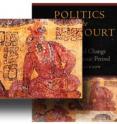The Ancient Maya and virtual worlds: Different perspectives on material meanings
If Facebook were around 1,400 years ago, the ancient Maya might have been big fans of the virtual self. The Maya believed that part of your identity could inhabit material objects, like a courtier's mirror or sculptor's carving tool. Maya might even name these objects, talk to them or take them to special events. They considered these items to be alive.
The practice of sharing your identity with material possessions might seem unusual in a modern context.
But is it that different from today's selfie-snapping, candy-crushing online culture, where social media profiles can be as important to a person's identity as his or her real-world interactions? Even money is virtual now, as digital currency such as Bitcoin gains popularity.
Research by University of Cincinnati assistant professor Sarah Jackson is beginning to uncover some interesting parallels between ancient Maya and modern-day views on materiality.
"This relates to a lot of things that people are feeling out right now about virtual realities and dealing with computers and social lives online," says Jackson, an anthropological archaeologist. "These things start to occupy this uncomfortable space where we question, 'Is it real, or is it not real?' I look at the Maya context and consider, 'How different is that from some of the concerns we have now?' There are some parallels in terms of preoccupation with roles that objects play and how attached we are to things."
Jackson will present her research "Classic Maya Material Meanings (and Modern Archaeological Consequences)" on April 25 at the Society for American Archaeology's (SAA) annual meeting, which runs through April 27 in Austin, Texas. More than 3,000 scientists from around the world attend the event to learn about research covering a broad range of topics and time periods.
THE MAYA PERSPECTIVE
For her research, Jackson uses hieroglyphic textual evidence to help her understand how the Maya might have viewed the material world. She's building a database of Maya material terminology and tracking certain property qualifiers -- visual markings on glyphs indicating from what material an object is made, like wood or stone.
Key to the process is trying to look at these property qualifiers from the Maya perspective. Jackson has found that the Maya applied property qualifiers in a broad manner, including some unexpected areas of divergence from literal interpretation.
For example, to the Maya, a temple might have "stony" qualities but so might a calendar or different things related to time. Other known Maya behaviors suggest belief in the concepts of object agency and partible personhood, meaning objects have the power to act in their own right and that the identity can be split into sections which can live outside the body.
So when Jackson analyzes a glyph that appears to show a Maya ruler having a conversation with his mirror or another that depicts a sculptor carving a "living" statue, it's important for her to overcome her own material assumptions.
"There are some really interesting possibilities if we can try to incorporate at least some kind of reconstructed understanding of how the Maya would have seen these materials, not just how we see them," Jackson says.
TRANSFORMING ARCHAEOLOGY
Jackson envisions potentially major changes in some fundamental aspects of archaeology, including the excavation process itself. She says even standard paperwork can encode certain assumptions and direct an archaeologist's interpretation in certain ways.
"It's really important to me that this isn't just abstract," Jackson says. "Let's see if we can think about how the Maya think, but let's also think about how this can transform what we're doing archaeologically."
Jackson plans to return to Belize next spring for additional field work, and she intends to test some experimental techniques. She's working with Christopher Motz, a doctoral student in UC's Department of Classics, to develop a database and interface for mobile tablet use in field work. The new technology is intended to allow researchers to catalog field data in a way that conveniently integrates traditional and new recording methods, similar to the innovative methods in use at UC's archaeological research project at Pompeii.
"Some of these things I'm thinking about could really shift how we characterize objects, how we record them, what is our vision of what they look like. And then how we construct ideas of assemblages, like how objects are relating to each other in a particular context and how we document them," Jackson says.


